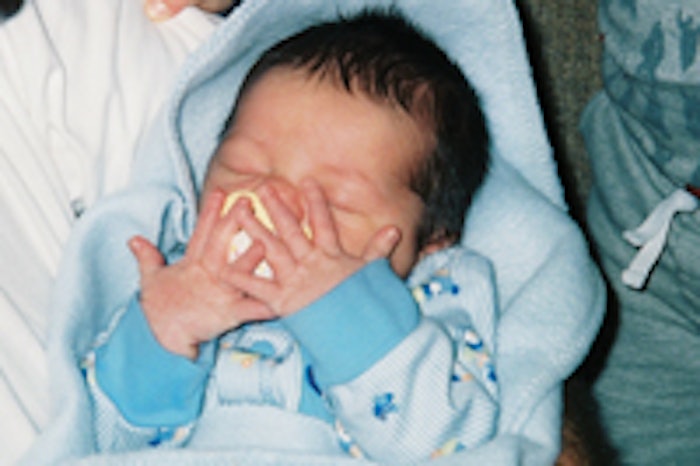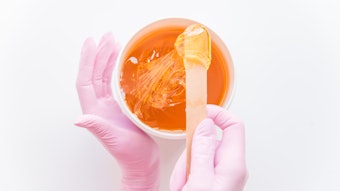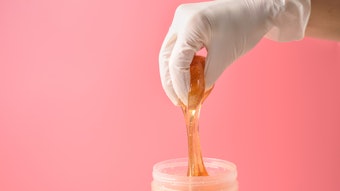
Understanding the treatment and care of skin as it develops from infancy through early childhood provides a unique opportunity to share in one of the most exciting and intimate experiences your clients will ever know, while creating an opportunity to enhance the strength and longevity of your business.
Most parents are perplexed by the unexpected skin problems that babies are born with or develop very early in life. Skin care professionals can support clients with insight and information about what to expect and how to handle an infant’s skin. Parents want to actively support the health of their babies and young children, but tend to overlook the role skin plays in the immune system. Unfortunately, many don’t understand the importance of finding products that are designed to address the critically important issue of prevention of chemical exposure. By providing information, education and products relevant to the journey into parenthood, you can be of service to your clients in a way that hasn’t been fully explored in the skin care industry.
Baby skin development
Skin goes through tremendous physiological development from ages 0 to 5. Infant skin is five times thinner than adult skin and doesn’t produce enough oil or melanin to adequately protect itself. The purpose of skin is to protect the body before it is even born, and many of the physical changes that keep a baby safer inside the womb are still visible at birth.
Lanugo. For example, babies are often born with a dark layer of hair called lanugo, which is Latin for “wool.” Lanugo is developed during approximately the fifth month in utero, probably to provide an insulating layer to help regulate temperature. Many babies shed this hair during the 40th week of pregnancy, but some are born with it. If this happens, you can assure your client that it will indeed fall out and be replaced by vellus hair, which is like peach fuzz.
Vernix. Vernix, which is Latin for “varnish,” can also cause new parents stress because it is a flaky, waxy white coating that slightly resembles cheese. In utero, vernix protects the sensitive skin of the fetus from becoming waterlogged by amniotic fluid. After birth, the vernix helps balance the skin’s pH, protects newborns from becoming scaly or dehydrated, and is believed to have antibacterial properties. Advise your client that vernix is a very healthy coating on the skin and not a symptom of dry or problem skin. Remnants of the vernix slough off naturally during the first couple weeks of life, but because it looks funny, it is often removed immediately after birth. You might suggest to your client that she ask her nurse to leave the vernix intact for as long as possible, especially for a baby born prematurely.
Natural products. Explain to your client that baby skin is much more permeable than adult skin because it is so thin. This heightened permeability at birth means incredible sensitivity to chemicals that can be passed transdermally into the bloodstream. Premature baby skin can be so permeable that the body can easily become dehydrated, infected and even accidentally poisoned. As more layers of horny cells develop with time, skin permeability is reduced. The combination of reduced functionality of the sebaceous glands and highly permeable skin make it very difficult for a baby to pass toxins out of the body through sweat. This is another reason why it is critically important to guide your clients toward natural, chemical-free products for an infant’s skin.
Fragrance. Interference from synthetic fragrances can be quite damaging, and the word “fragrance” on a label may indicate as many as 4,000 synthetic chemicals, many of which can cause skin discoloration, irritation, coughing and vomiting. Even more troubling, they can also affect the central nervous system, causing depression, hyperactivity and irritability.1–4 Finding products that are fragrance-free is essential to support health and enhance mother-baby bonding. On the other hand, the right aromatherapy oils—in less than .05% total concentration—can benefit the parenting relationship by enhancing feelings of joy, cooperation and happiness during bonding experiences, such as bathing and massage. Rose, chamomile and lavender aromatherapy oils, blended together at the right ratios, can provide wonderful benefits when used properly.
Touch. Perhaps the most delightful function of baby skin is the ability to receive love and affection through the sense of touch. Tactile stimulation through the epidermis allows your client to reassure, nurture and love with a gentle caress. In addition to emotional support, research shows that frequent touching is equally important for physical and cognitive development. Babies who are cuddled, rocked, massaged and cradled grow more quickly and soundly, exhibit more playfulness and less fear, tolerate stress better and have stronger immune systems.5
Products
Maximum health of the skin—and therefore the immune system—can be developed through proper cleansing, massage and the topical application of creams and ointments. Because of environmental contaminants and delayed dermal development, any number of natural catalysts, such as environmental pollutants, allergies, hormones, genetics, bodily fluids and even the weather, can trigger skin problems. Young skin flares up so frequently that rashes account for about 30% of unscheduled visits to the pediatrician’s office.6
Baby skin care requires four types of products: cleansers, treatments, moisturizers and sun care. Every product must be naturally protective to provide auxiliary support for the immune system with hydration, pH balancing, physical protection and antioxidizing activity at a cellular level. Even a basic baby cleanser should help strengthen and maintain a baby’s immunity.
Cleansers. Frequent baths can damage the integrity of a baby’s skin. Advise your client to spot-cleanse her baby many times daily and give a full bath only two to three times per week. Cleansing ingredients, such as thyme oil and plant- or sugar-derived surfactants are extra gentle, highly effective and nonirritating. Avoid any products that contain sulfates and alcohol in the base composition. Antibacterial soaps are very dehydrating and may pass toxins through a baby’s thin skin. Antibacterial products also disrupt the skin’s natural ecosystem by damaging the balance of healthy bacteria.
Treatments. The key to keeping baby’s first line of defense operating at full capacity is to maintain its hydration, preventing rashes and having the right balance between healthy cells and healthy bacteria so its immune functions can work efficiently. Although some of the following skin conditions are considered normal, many cause pain and could be indicative of bigger health issues. The skin provides your client with a tool to help measure her baby’s health. It is a window into the body’s internal condition and mirrors its external environment. Its ability to communicate stability and imbalance has been used for thousands of years as a primary diagnostic tool in nearly every form of medicine, Eastern and Western alike.
Dry skin. Because oil glands are underdeveloped, baby skin is always at a high risk of becoming severely dry. In fact, recent studies show that 60% of baby skin is dehydrated at any given time, but 90% of parents think that their baby’s skin is not dehydrated.7 Over-cleansing, weather conditions and irritants in toiletry products exacerbate dry skin, and result in cracks, infections and painfully sensitive areas. For dry skin, it is imperative that your client use hydrating, heavy creams that include daily sun protection to prevent secondary problems, such as cracking and infection.
Rash. A painful rash can occur anywhere on the body, and is most likely to show up in the diaper area, under the arms, in the leg folds and under the chin. Rashes are often caused by a food or an environmental contaminant of some kind. The best solution is to calm redness, treat pain and prevent infection by using natural creams, salves and zinc ointments. Excess heat can be trapped in the skin if your client uses products with petroleum by-products and irritants. These will likely slow the healing time of any rash. The products you recommend should create a protective, nurturing environment without exposing your client’s baby to unnecessary environmental contaminants, such as synthetic fragrances. If a rash persists for seven days, advise your client to consult her physician.
Cradle cap. Waxy-looking patches of brown- or clay-colored skin on the scalp are not painful and can be worked loose by gently massaging moisturizing ingredients, such as olive oil and shea butter, into the affected area. Brush well, rinse clean and repeat for several days, but beware of over-cleansing, which can lead to other skin problems.
Acne. Baby acne, often caused by residual maternal hormones in the baby’s body, often occurs at two or three months of age and looks a lot like adult acne. It usually disappears without treatment after four to six weeks, but the uncomfortable symptoms can be treated with soothing, calming ingredients, such as oat extract, neem oil and calendula to reduce inflammation, prevent infection and minimize discomfort.
Eczema. Eczema affects about 20% of babies.8 It is often hereditary, and looks red and scaly. It can be irritating and has the potential to lead to infection. Eczematic skin is particularly vulnerable and sensitive; it can rash up in the presence of specific triggers, such as soy products, milk or a particular skin care product. Determining triggers and minimizing flareups can be a long process. Hydrating organic jojoba oil and natural antibacterial ingredients, such as neem oil, are helpful to sooth and prevent secondary infection. You should recommend a physician’s visit for any scaly skin condition on a baby.
Psoriasis. Psoriasis, which causes skin cells to shed more quickly than they should, will make the baby’s epidermis appear red, scaly and thick. Psoriatic skin is not fully functional, but it probably isn’t more susceptible to increased toxic uptake because it is generally even less permeable than healthy skin. As with eczema, this condition may be successfully treated and even prevented with nonpharmaceutical products under your care or the direction of a pediatrician.
Moisturizers. The skin must be properly hydrated at all times to maintain ample strength and immunity, especially to defend against the damaging effects of air conditioning, polluted air, and windy or cold environments. The use of humidifiers or living in a naturally humid environment is very beneficial for the skin and may help reduce the need to use moisturizers. Daily moisturizing products provide wonderful benefits to the skin in both their composition, and the incorporation of a little massage during application. Moisturizing ingredients to look for include a host of excellent natural options from pure aloe or noni gel to delicious plant oils, such as avocado oil or apricot kernel oil. As always, advise your clients to avoid petroleum by-products and preservatives.
Sun care. Most sun damage will occur before a child is 18 years old. Because of the low levels of melanin production in an infant’s skin and its extreme sensitivity, physicians recommend avoiding both sun exposure and the use of sunscreen until at least six months of age. After six months, chemical-free zinc- or titanium-based products with SPF 35 or higher should be used all over the body, even under clothes. Lip protection is especially important to apply and reapply often, because much of it is quickly wiped or licked off. Avoid synthetic sunscreen chemicals because some are known to mimic estrogens (xenoestrogens) and may be linked to hormonal developmental problems in young children.9, 10 Also, remind your client that a baby needs a higher SPF than an adult to get the same protective value.
Your role
Toxins in the environment are linked to severe health problems and diseases, such as cancer, premature menses and altered brain chemistry. Minimizing the impact of environmental toxins for everyone, especially babies, should be a priority for skin care professionals and parents. When your client better understands the skin’s role in her baby’s health and immunity, she is empowered. Her choice to create a natural, toxin-free environment for the skin is one that actively supports her baby’s development and immune system. When, as a respected professional, you recommend against the widespread use of neurotoxins, xenohormones and other chemicals contained in many of the products targeted for the children’s skin care market, you leverage a powerful influence on creating a better future for all.
REFERENCES
1. www.immuneweb.org/articles/fragrancelist.html
3. http://www.herc.org/news/perfume/risks.htm
4. U.S. House of Representatives, Neurotoxins: At Home and the Workplace, The Committee on Science & Technology, Report 99–827 (Sept 16, 1986)
5. A Lampert, The Appearance of Love, The Evolution of Love, Greenwood Publishing Group, Santa Barbara, CA, 22–23 (1997)
6. NL Novick, MD, Baby Skin: A Leading Dermatologist’s Guide to Infant and Childhood Skin Care, Three Rivers Press, New York (1991)
7. www.jnj.com
8. query.nytimes.com/gst/fullpage.html?res=9C06E1D61638F933A05753C1A96E9C8B63&sec=&spon=&pagewanted=all
9. www.pubmedcentral.nih.gov/articlerender.fcgi?artid=1240241
10. toxsci.oxfordjournals.org/cgi/content/full/54/1/138?ck=nck
(Web sites all accessed May 5, 2009)
Editor’s note: It is important to advise clients to consult their pediatricians before administering any treatments for their babies in order to avoid possible contraindications.










